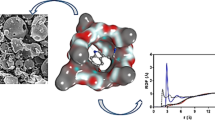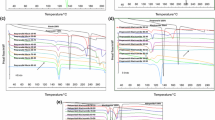Abstract
One of the new synthetic cathinones that has a high tendency to replace ecstasy and other established synthetic drugs is N-ethylpentylone, (NEP), due to its high potency, stimulative, hedonic and hallucinatory effects. In order to examine the interactions of N-ethylpentylone, the apparent molar quantities, thermal expansion coefficient and the apparent molar volume at infinite dilution were calculated from the experimental measurements of the density of NEP aqueous solutions in different temperature and molality ranges, from T = (293.15 to 313.15) K and from m = (0.0590 to 0.0977) mol·kg−1, respectively. The taste of N-ethylpentylone was estimated by calculated values of apparent specific molar volume at infinite dilution and it was concluded that its taste in aqueous solutions is bitter. Also, using the spectrofluorimetric technique, an intermolecular deactivation of in situ formed ethidium bromide (EB) complex with DNA (EB-DNA) was investigated in the presence of N-ethylpentylone. Obtained results indicated good affinity and efficiency of NEP to substitute EB from the EB-DNA complex via intercalation mode. Using molecular docking, it was concluded that the binding energy obtained for NEP indicates its higher affinity to interact with DNA, compared to methamphetamine and amphetamine, but lower compared to ecstasy. The affinity of NEP to bind to bovine serum albumin (BSA) was also investigated and discussed. It is shown that N-ethylpentylone could be efficiently transported and distributed through the blood and cells.







Similar content being viewed by others
References
https://www.unodc.org/LSS/Page/NPS. Accessed 20 August 2022
The challenge of new psychoactive substances, Global SMART Program, United Nations Office on Drugs and Crime, United Nations Publication, Austria (2013)
Majchrzak, M., Celinski, R., Kus, P., Kowalska, T., Sajewicz, T.M.: The newest cathinone derivatives as designer drugs: an analytical and toxicological review. Forensic Toxicol. 36, 33–50 (2018)
Ikeji, C., Sittambalam, C.D., Camire, L.M., Weisman, D.S.: Fatal intoxication with N-ethylpentylone: a case report. J. Community Hosp. Intern. Med. Perspec. 8, 307–310 (2018)
Capriola, M.: Synthetic cathinones abuse. Clin. Pharmacol. 5, 109–115 (2013)
Valente, M.J., de GuedesPinho, P., de LourdesBastos, M., Carvalho, F., Carvalho, M.: Khat and synthetic cathinones: a review. Arch. Toxicol. 88, 15–45 (2014)
https://www.unodc.org/LSS/SubstanceGroup/Details/67b1ba69-1253-4ae9-bd93-fed1ae8e6802. Accessed 04 Jan 2022
https://www.emcdda.europa.eu/publications/drug-profiles/synthetic-cathinones_en. Accessed 04 Jan 2022
Critical review report: N-ethylnorpentylone, World Health Organisation, Geneva, 2018. https://www.who.int/medicines/access/controlled-substances/N-Ethylnorpentylone.pdf. Accessed 14 Jan 2022
Wood, M.R., Bernal, I., Lalancette, R.A.: The hydrochloride hydrates of pentylone, and dibytilone and the hydrochloride salt of ephylone: the structures of three novel designer cathinones. Struct. Chem. 28, 1369–1376 (2017)
Krotulski, A.J., Papsun, D.M., De Martinis, B.S., Mohr, A.L.A., Logan, B.K.: N-Ethyl pentylone (ephylone) intoxications: quantitative confirmation and metabolite identification in authentic human biological specimens. J. Anal. Toxicol. 42, 467–475 (2018)
Eiden, C., Vuillot, O., Serre, A., Gambier, J., Berger, A., Mathieu, O., Nefau, T., Sebbane, M., Donnadieu-Rigole, H., Peyriere, H.: Acute psychiatric disorders related to fake cathinone: ephylone. Toxicol. Anal. Clin. 31, s64 (2019)
German, C.L., Fleckenstein, A.E., Hanson, G.R.: Bath salts and synthetic cathinones: an emerging designer drug phenomenon. Life Sci. 97, 2–8 (2014)
https://www.emcdda.europa.eu/system/files/publications/2473/TD0116348ENN.pdf. Accessed 21 Feb 2022
Oliver, C.F., Palamar, J.J., Salomone, A., Simmons, S.J., Philogene-Khalid, H.L., Stokes-McCloskey, N., Rawls, S.M.: Synthetic cathinone adulteration of illegal drugs. Psychopharmacology 236, 869–879 (2019)
Zawadzki, M., Nowak, K., Szpot, P.: Fatal intoxication with N-ethylpentylone: a case report and method for determining N-ethylpentylone in biological material. Forensic Toxicol. 38, 255–263 (2020)
Thirakul, P., Hair, L.S., Bergen, K.L., Pearson, J.M.: Clinical presentation, autopsy results and toxicology findings in an acute N-ethylpentylone fatality. J. Anal. Toxicol. 41, 342–346 (2017)
Lin, Z., Chen, Y., Li, J., Xu, Z., Wang, H., Lin, J., Ye, X., Zhao, Z., Shen, Y., Zhang, Y., Zheng, S., Rao, Y.: Pharmacokinetics of N-ethylpentylone and its effect on increasing levels of dopamine and serotonin in the nucleus accumbens of conscious rats. Addict. Biol. 25, e12755 (2020)
Leong, H.S., Philp, M., Simone, M.P., Witting, K., Fu, S.: Synthetic cathinones induce cell death in dopaminergic SH-SY5Y cells via stimulating mitochondrial dysfunction. Int. J. Mol. Sci. 21, 1370–1390 (2020)
Bhattacharya, D.M., Kawadkar, D.V., Pandhurnekar, C.P., Wankhade, A.V., Pratap, U.R., Zodape, S.P.: Investigation of volumetric and acoustic properties of procainamide hydrochloride in aqueous binary and (water + amino acid) ternary mixtures at different temperatures. J. Chem. Eng. Data 62, 4083–4092 (2017)
Vraneš, M., Tot, A., Panić, J., Tot, A., Papović, S., Gadžurić, S.: Structure making properties of 1-(2-hydroxyethyl)-3-methylimidazolium chloride ionic liquid. J. Chem. Thermodyn. 95, 174–179 (2016)
Vraneš, M.B., Panić, J.J., Tot, A.S., Papović, S.M., Ostojić, S.M., Gadžurić, S.B.: The solvation properties and effect of D-fructose on the taste behavior of Citrus aurantium active components in aqueous solutions. Food Funct. 9, 5569–5579 (2018)
Sirajuddin, M., Badshah, S.A.A.: Drug-DNA interactions and their study by UV-Visible, fluorescence spectroscopies and cyclic voltametry. J. Photochem. Photobiol. B. 124, 1–19 (2013)
Schrödinger Suite, Glide, Schrödinger, LLC; New York (2015)
Boys, F., Bernardi, F.: The calculation of small molecular interactions by the differences of separate total energies. Some procedures with reduced errors. Mol. Phys. 19, 553–566 (1970)
Rostkowski, M., Olsson, M., Sondergaard, C., Jensen, J.: Graphical analysis of pH-dependent properties of proteins predicted using PROPKA. BMC Struct. Bio. 11, 1–6 (2011)
Jorgensen, W.L., Tirado-Rives, J.: Potential energy functions for atomic-level simulations of water and organic and biomolecular systems. Proc. Natl. Acad. Sci. 102, 6665–6670 (2005)
Elokely, K.M., Doerksen, R.J.: Docking challenge: protein sampling and molecular docking performance. J. Chem. Inf. Model. 53, 1934–1945 (2013)
Masson, D.O.: XXVIII. Solute molecular volumes in relation to solvation and ionization. Lond. Edinb. Dublin Philos. Mag. J. Sci. 8, 218–235 (1929)
Vraneš, M., Tot, A., Zec, N., Papović, S., Gadžurić, S.: Volumetric properties of binary mixtures of 1-butyl-3-methylimidazolium tris(pentafluoroethyl)trifluorophosphate with N-methylformamide, N-ethylformamide, N,N-dimethylformamide, N,N-dibutylformamide, and N,N-dimethylacetamide from (293.15 to 323.15) K. J. Chem. Eng. Data. 59, 3372–3379 (2014)
Dožić, S., Vraneš, M., Gadžurić, S.: Volumetric properties of ammonium nitrate in N-methylformamide. J. Mol. Liq. 193, 189–193 (2014)
Birch, G.G., Parke, S., Siertsema, R., Westwell, J.M.: Specific volumes and sweet taste. Food Chem. 56, 223–230 (1996)
Birch, G.G., Parke, S., Siertsema, R., Westwell, J.M.: Importance of molar volumes and related parameters in sweet taste chemoreception. Pure Appl. Chem. 69, 685–692 (1997)
Shiri, F., Hadidi, S., Rahimi-Nasrabadi, M., Ahmadi, F., Reza, G.M., Ehrlich, H.: Synthesis, characterization and DNA binding studies of a new ibuprofen–platinum(II) complex. J. Biomol. Struct. Dyn. 38(4), 1119–1129 (2020)
Reis, A., Gonçalves, I., Neto, A.F., Santos, A., Kuca, K., Nepovimova, E., Neto, A.M.: Intermolecular interactions between DNA and Methamphetamine, Amphetamine, Ecstasy and their major metabolites. J. Biomol. Struct. Dyn. 36, 3047–3057 (2018)
Brown, J.R.: Albumin structure, function and uses. In: Rosenoer, V.M., Oratz, M., Rothschild, M.A. (eds.), pp. 27–51. Pergamon Press, Oxford (1977)
Funding
This work is performed under financial support of the Ministry of Education, Science and Technological Development of the Republic of Serbia (Grant No. 451-03-68/2020-14/200125). The authors hereby declare no existing financial interests concerning these research studies.
Author information
Authors and Affiliations
Contributions
SB, MPM and NCB conducted measurements, sample preparation, calculation of volumetric properties and wrote the first draft of the manuscript; NJ measured interactions with biomacromolecules; AT performed molecular docking; NRS supplied chemicals and seizure illicit drug samples; JN, MV and SG interpreted results and reviewed manuscript.
Corresponding author
Ethics declarations
Competing interests
The authors have no competing interests as defined by Springer, or other interests that might be perceived to influence the results and/or discussion reported in this paper.
Additional information
Publisher's Note
Springer Nature remains neutral with regard to jurisdictional claims in published maps and institutional affiliations.
Supplementary Information
Below is the link to the electronic supplementary material.
Rights and permissions
Springer Nature or its licensor (e.g. a society or other partner) holds exclusive rights to this article under a publishing agreement with the author(s) or other rightsholder(s); author self-archiving of the accepted manuscript version of this article is solely governed by the terms of such publishing agreement and applicable law.
About this article
Cite this article
Belić, S., Miličević, M.P., Vraneš, M. et al. Insights into Interactions of N-Ethylpentylone Drug with Water and Biomacromolecules. J Solution Chem (2024). https://doi.org/10.1007/s10953-024-01369-5
Received:
Accepted:
Published:
DOI: https://doi.org/10.1007/s10953-024-01369-5




